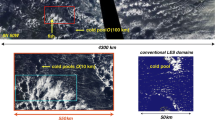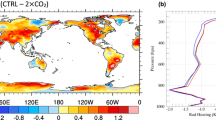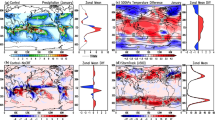Abstract
Recently, a new conceptual framework for deep convection scheme triggering and closure has been developed and implemented in the LMDZ5B general circulation model, based on the idea that deep convection is controlled by sub-cloud lifting processes. Such processes include boundary-layer thermals and evaporatively-driven cold pools (wakes), which provide an available lifting energy that is compared to the convective inhibition to trigger deep convection, and an available lifting power (ALP) at cloud base, which is used to compute the convective mass flux assuming the updraft vertical velocity at the level of free convection. While the ALP closure was shown to delay the local hour of maximum precipitation over land in better agreement with observations, it results in an underestimation of the convection intensity over the tropical ocean both in the 1D and 3D configurations of the model. The specification of the updraft vertical velocity at the level of free convection appears to be a key aspect of the closure formulation, as it is weaker over tropical ocean than over land and weaker in moist mid-latitudes than semi-arid regions. We propose a formulation making this velocity increase with the level of free convection, so that the ALP closure is adapted to various environments. Cloud-resolving model simulations of observed oceanic and continental case studies are used to evaluate the representation of lifting processes and test the assumptions at the basis of the ALP closure formulation. Results favor closures based on the lifting power of sub-grid sub-cloud processes rather than those involving quasi-equilibrium with the large-scale environment. The new version of the model including boundary-layer thermals and cold pools coupled together with the deep convection scheme via the ALP closure significantly improves the representation of various observed case studies in 1D mode. It also substantially modifies precipitation patterns in the full 3D version of the model, including seasonal means, diurnal cycle and intraseasonal variability.


















Similar content being viewed by others
Notes
The fifth phase of Coupled Model Intercomparison Project.
EUROpean Cloud Systems.
References
Ackerman A, Toon O, Stevens D, Heymsfield A, Ramanathan V, Welton E (2000) Reduction of tropical cloudiness by soot. Science 288:1042
Arakawa A, Chen JM (1987) Closure assumptions in the cumulus parameterization problem. Collection of papers at symposium of short- and medium range numerical prediction, Tokyo, Japan, WMO/IUGG NWP
Arakawa RA, Schubert WH (1974) Interaction of a cumulus cloud ensemble with the large scale environment. part I. J Atmos Sci 31:674–701
Bony S, Emanuel KA (2001) A parameterization of the cloudiness associated with cumulus convection; evaluation using TOGA COARE data. J Atmos Sci 58:3158–3183
Bony S, Dufresne JL, Le Treut H, Morcrette JJ, Senior C (2004) On dynamic and thermodynamic components of cloud changes. Clim Dyn 22:71–86
Bretherton C, McCaa J, Grenier H (2004) A new parameterization for shallow cumulus convection and its application to marine subtropical cloud-topped boundary layers. Part I: description and 1D results. Mon Wea Rev 132:864–882
Couvreux F, Hourdin F, Rio C (2010) Resolved versus parameterized boundary-layer plumes. Part I: a parameterization-oriented conditional sampling in large-eddy simulations. Boun Layer Meteor 134(3):441–458
Couvreux F, Rio C, Guichard F, Lothon M, Canut G, Bouniol D, Gounou A (2012) Initiation of local convection in a semi-arid region analyzed with Large-Eddy Simulations and AMMA observations. Q J R Meteorol Soc 138:56–71
Del Genio AD (2011) Representing the sensitivity of convective cloud systems to tropospheric humidity in general circulation models. Surv Geophys. doi:101007/s10712-011-9148-9
Del Genio AD, Yao MS (1993) Efficient cumulus parameterization for long-term climate studies: the GISS scheme. In: The representation of cumulus convection in numerical models, AMS Meteor Monograph KA Emanuel and DA Raymond, Eds, no 46 American Meteorological Society 24:181–184
Derbyshire SH, Beau I, Bechtold P, Gandpeix JY, Piriou JM, Redelsperger JL, Soares P (2004) Sensitivity of moist convection to environmental humidity. Q J R Meteorol Soc 130:3055–3079
Donner L, Phillips VT (2003) Boundary layer control on convective available potential energy: Implications for cumulus parameterizations. J Geophys Res 108. doi:10.1029/2003JD003,773
Donner LJ (1993) A cumulus parametrization including mass-fluxes, vertical momentum dynamics, and mesoscale effects. J Atmos Sci 50:889–906
Emanuel KA (1991) A scheme for representing cumulus convection in large-scale models. J Atmos Sci 48:2313–2335
Emanuel KA, Zivkovic-Rothman M (1999) Development and evaluation of a convection scheme for use in climate models. J Atmos Sci 56:1766–1782
Fridlind AS, Ackerman AM, Chaboureau JP, Fan J, Grabowski WW, Hill A, Jones TR, Khaiyer MM, Liu G, Minnis P, Morrison H, Nguyen L, Park S, Petch JC, Pinty JP, Schumacher C, Shipway B, Varble AC, Wu X, Xie S, Zhang M (2012) A comparison of TWP-ICE observational data with cloud-resolving model results. J Geophys Res 117:D05,204
Grandpeix JY, Lafore JP (2010) A density current parameterization coupled to emanuel’s convection scheme. part i: the models. J Atmos Sci 67(4):881–897
Grandpeix JY, Lafore JP, Cheruy F (2010) A density current parameterization coupled to emanuel’s convection scheme. part ii: 1d simulations. J Atmos Sci 67(4):898–922
Guichard F, Petch J, Redelsperger J, Bechtold P, Chaboureau J, Cheinet S, Grabowski W, Grenier H, Jones C, Koehler M, Piriou JM, Tailleux R, Tomasini M (2004) Modelling the diurnal cycle of deep precipitating convection over land with cloud-resolving models and single column models. Q J R Meteorol Soc 130:3139–3172
Hourdin F, Couvreux F, Menut L (2002) Parameterisation of the dry convective boundary layer based on a mass flux representation of thermals. J Atmos Sci 59:1105–1123
Hourdin F, Musat I, Bony S, Braconnot P, Codron F, Dufresne JL, Fairhead L, Filiberti MA, Friedlingstein P, Grandpeix JY, Krinner G, LeVan P, Li ZX, Lott F (2006) The LMDZ4 general circulation model: climate performance and sensitivity to parametrized physics with emphasis on tropical convection. Clim Dyn 27:787–813
Hourdin F, Grandpeix JY, Rio C, Bony S, Jam A, Cheruy F, Rochetin N, Fairhead L, Idelkadi A, Musat I, Dufresne JL, Lefebvre MP, Lahellec A, Roehrig R (2012) From IPSL-CM5A to IPSL-CM5B: revisiting the parameterization of boundary-layer, clouds and convection in the LMDZ atmospheric model. Clim Dyn. doi: 10.1007/s00382-012-1343-y
Houze RA, Hobbs PV (1982) Organization and structure of precipitating cloud systems. Adv Geophys 24:225–315
Houze RA (1977) Structure and dynamics of a tropical squall-line system. Mon Wea Rev 105:1540–1567
Huffman GJ, Adler R, Morrissey MM, Bolvin DT, Curtis S, Joyce R, McGavock B, Susskind J (2001) Global precipitation at one degree daily resolution from multisatellite observations. J Hydrometeorol 2:36–50
Jones TR, Randall DA (2011) Quantifying the limits of convective parameterizations. J Geophys Res 106:D08,210. doi:10.1029/2010JD014913
Jorgensen DP, Lemone MA (1989) Vertical velocity characteristics of oceanic convection. J Atmos Sci 46:621–640
Kuang Z, Bretherton CS (2006) A mass-flux scheme view of a high-resolution simulation of a transition from shallow to deep convection. J Atmos Sci 63:1895–1909
Kummerov C et al. (2001) The evolution of the Goddard profiling algorithm (GPROF) for rainfall estimation from passive microwave sensors. J Appl Met 40:1801–1820
Lafore JP, Stein J, Asencio N, Bougeault P, Ducrocq V, Duron J, Fisher C, Hreil P, Mascart P, Masson V, Pinty JP, Redelsperger JL, Richard E, Vil-Guerau de Arellano J (1998) The Meso-NH atmospheric simulation system. Part I: adiabatic formulation and control simulations. Ann Geophys 16:90–109
Laval K, Sadourny R, Serafini Y (1981) Land surface processes in a simplified general circulation model. Geophys Astrophys Fluid Dyn 17:129–150
LeMone MA, Pennell WT (1976) The relationship of trade wind cumulus distribution to subcloud layer fluxes and structure. Mon Wea Rev 104:524–539
Lemone MA, Zipser EJ (1980) Cumulonimbus vertical velocity events in GATE. Part I: diameter, intensity and mass-flux. J Atmos Sci 37:2444–2457
Lima MA, Wilson JW (2008) Convective storm initiation in a moist tropical environment. Mon Wea Rev 136:1847–1864
Lothon M, Campistron B, Chong M, Couvreux F, Guichard F, Rio C, Williams E (2011) Life cycle of a mesoscale circular gust front observed by a C-band Doppler radar in West Africa. Mon Wea Rev 139:1370–1388
Lucas C, Zipser EJ, Lemone MA (1994) Vertical velocity in oceanic convection off Tropical Australia. J Atmos Sci 51:3183–3193
Mapes B (2000) Convective inhibition, subgrid-scale triggering energy, and stratiform instability in a toy tropical wave model. J Atmos Sci 57:1515–1535
Moncrieff MW, Miller MJ (1976) The dynamics and simulation of tropical cumulonimbus and squall lines. Q J R Meteorol Soc 102:373–394
Qian L, Young GS, Frank WM (1998) A convective wake parameterization scheme for use in general circulation models. Mon Wea Rev 126:456–469
Redelsperger JL, Guichard F, Mondon S (2000) A parameterization of mesoscale enhancement of surface fluxes for large-scale models. J Clim 13:402–421
Rio C, Hourdin F (2008) A thermal plume model for the convective boundary layer: representation of cumulus clouds. J Atmos Sci 65:407–425
Rio C, Hourdin F, Grandpeix JY, Lafore JP (2009) Shifting the diurnal cycle of parameterized deep convection over land. Geophys Res Lett 36:L07,809. doi:10.1029/2008GL036779
Rio C, Hourdin F, Couvreux F, Jam A (2010) Resolved versus parameterized boundary-layer plumes. Part II: continuous formulations of mixing rates for mass-flux schemes. Boun Layer Meteor 135:469–483
Rozbicki JJ, Young G, Qian L (1999) Test of a convective wake parameterization in the single column version of CCM3. Mon Wea Rev 127:1347–1361
Steiner M, Houze R, Yuter SE (1995) Climatological characterization of three-dimensional storm structure from operational radar and rain gauge data. J Appl Met 34:1978–2007
Stevens DE, Ackerman AS, Bretherton CS (2002) Effects of domain size and numerical resolution on the simulation of shallow cumulus convection. J Atmos Sci 59:3285–3301
Taylor KE, Stouffer RJ, A MG (2012) An overview of CMIP5 and the experiment design. Bull Am Meteorol Soc 93:485–498
Tiedtke M (1989) A comprehensive mass flux scheme for cumulus parameterization in large-scale models. Mon Wea Rev 117:1179–1800
Varble AM, Fridlind A, Zipser EJ, Ackerman AS, Chaboureau JP, Fan J, Hill A, McFarlane SA, Pinty JP, Shipway B (2011) Evaluation of cloud-resolving model intercomparison simulations using TWP-ICE observations: precipitation and cloud structure. J Geophys Res 116:D12,206
Xie S, Hume T, Jakob C, Klein S, Mccoy R, Zhang M (2010) Observed large-scale structures and diabatic heating and drying profiles during TWP-ICE. J Clim 23:57–79
Xu KM, Randall DA (2000) Updraft and downdraft statistics of simulated tropical and midlatitude cumulus convection. J Atmos Sci 58:1630–1649
Yamada T (1983) Simulations of nocturnal drainage flows by a q 2 l turbulence closure model. J Atmos Sci 40:91–106
Zhu P, Dudhia J, Field PR, Wapler K, Fridlind A, Varble A, Zipser E, Petch J, Chen M, Zhu Z (2012) A limited area model (LAM) intercomparison study of a TWP-ICE active monsoon mesoscale convective event (submitted to JGR)
Zipser EJ (1969) The role of organized unsaturated convective downdrafts in the structure and rapid decay of an equatorial disturbance. J Appl Met 8:799–814
Zipser EJ, Lemone MA (1980) Cumulonimbus vertical velocity events in GATE. Part II: synthesis and model core structure. J Atmos Sci 37:2458–2469
Author information
Authors and Affiliations
Corresponding author
Additional information
This paper is a contribution to the special issue on the IPSL and CNRM global climate and Earth System Models, both developed in France and contributing to the 5th coupled model intercomparison project.
Rights and permissions
About this article
Cite this article
Rio, C., Grandpeix, JY., Hourdin, F. et al. Control of deep convection by sub-cloud lifting processes: the ALP closure in the LMDZ5B general circulation model. Clim Dyn 40, 2271–2292 (2013). https://doi.org/10.1007/s00382-012-1506-x
Received:
Accepted:
Published:
Issue Date:
DOI: https://doi.org/10.1007/s00382-012-1506-x




